Hexavalent Chromium Removal from Water Using Heat-Acid Activated Red Mud ()

1. Introduction
Hexavalent chromium is one of the heavy mental contaminants found in the water which is used in a variety of applications including electroplating, steel production, leather tanning, mining and textile dyeing [1] . Chromium usually exists in both trivalent and hexavalent forms in water, and trivalent chromium is an essential trace element for human and plays a vital role in normal carbohydrate, lipid and protein metabolism [2] . It is poisonous only at high concentration [3] . Hexavalent chromiumis highly toxic, it can cause diseases like dermatitis, damage to liver, kidney circulation, lung cancer and even death [4] . According to the recommendation of The World Health Organization (WHO), the maximum allowable limit for total chromium in drinking water is at the level of 0.05 mg∙L−1 [5] .
Many methods have been reported for hexavalent chromium removal such as chemical precipitation [6] , membrane filtration [7] , ion exchange [8] , electrolytic [9] and adsorption [10] . Among all the above mentioned methods, adsorption is a promising method due to its high efficient, low cost, flexibility and simplicity of design, ease of operation, avoiding the formation of secondary pollutants and so on. A variety of materials have used as hexavalent chromium sorbents, including activated carbon, zeolite, bentonite, biological materials, fly ash, red mud and others [11] -[16] .
Red mud (RM) emerges as a waste by-product during the alkaline leaching of bauxite in the Bayer process. Owing to its chemical stability and structural properties, RM has been found to remove heavy metals, phosphate [17] , dyes [18] from aqueous solution. In the present work an attempt has been made to use the acidified red mud (ARM) as an adsorbent for the removal of hexavalent chromium from model aqueous solution, to investigate the effect of contact time, initial solution pH and temperature on the adsorption, and to discuss the adsorption isotherm of ARM for hexavalent chromium.
2. Experimental
2.1. Adsorbent Preparation
The RM sample used in this study was obtained from Wenshan Aluminum Industry Corporation, Yunnan province, China. The chemical composition of RM is: SiO2 (17.56%), Fe2O3 (34.33%), Al2O3 (17.09%), CaO (16.84%), MgO (0.46%), K2O (0.04%) and Na2O (2.88%).
The RM is screened through a 100 mesh screen and dried at 105˚C. RM was boiled in 0.5 M HCl solution for 2 h at 80˚C, the ratio of liquid to solid was 20 mg∙L−1. Finally, the acidified ARM samples were heated at 105˚C to get constant weight and stored in the valve bag for further study [19] .
2.2. Characterization of the Adsorbent
The surface morphology of RM before and after modification was observed by a scanning electron microscopy performed using a FEI Quanta 200 electron microscopy (Holland). X-ray fluorescence spectrometry (XRF, ZSX100e, Japan) has been used for analysis the elemental change of RM before and after modification. X-ray diffraction (XRD, TTR111, Japan) measurements were used nickel filtered Cu Ka radiation (40 KV, 20 mA). The patterns are recorded in the 2θ range 10˚ - 70˚ with a scanning speed of 30˚ min−1.
2.3. Hexavalent Chromium Adsorption Experiments
A stock solution (100 mg∙L−1) of hexavalent chromium was prepared by dissolving analytical grade K2Cr2O7 into distilled water. The test solution of hexavalent chromium used in each study was prepared by diluting the stock solution. The pH value for test solution was adjusted by 0.1 M HCl and 0.1 M NaOH. A fixed amount of dry adsorbents 0.5 g was added to a series of capped conical flasks containing 100 mL of 0.08 mg∙L−1 K2Cr2O7 solution and shaken at 100 rpm using a constant temperature bath oscillator (SHA-C, China). A number of experimental variables such as adsorbent dosage (0.1 - 4 g), contact time (10 - 240 min), pH (2 - 12) and temperature (25˚C - 45˚C) which affect the adsorption process have been studied to investigate the removal process. After shaking for a period of predetermined time, the solutions were allowed to settle for 10 min and the samples were centrifuged at 3000 rpm for 10 min. Concentrations of hexavalent chromium in the filtrate were determined spectrophotometrically using diphenylcarbazide solution at λ = 540 nm.
The amount of hexavalent chromium adsorbed per unit mass of the adsorbent (Qe) was computed by using the following expression:
 (1)
(1)
where C0 (mg∙L−1) and Ce (mg∙L−1) are the initial and final concentrations of hexavalent chromium in the aqueous solutions (mg∙L−1), respectively. V is the solution volume (mL) and m is the amount of adsorbent (g).
The adsorption efficiency was determined as below:
ŋ (2)
(2)
where ŋ is the adsorption efficiency of hexavalent chromium on ARM (%). The average of adsorption efficiency with three repeats was reported in this study.
3. Result and Discussion
3.1. Characterizations of ARM
The RM and ARM were observed by scanning electron microprobe at 10,000× magnification. The SEM images in Figure 1 may provide visual evidence of the effect of on the RM surface erosion and collapse. When RM was treated with HCl, the oxides of iron, calcium, sodium and aluminum are converted to their respective chlorides. Calcium and some other acid-soluble salts were partially dissolved, and then some coarse exterior and new cavities appeared during the RM acidification process [20] . The acidic surface treatments lead to the development of micropores or mesopores on the RM surface and create localized adsorption sites on the RM surface [21] . It is the reason why the acidic treatment could result in a greater specific surface area and porosity.
Figure 2 displays the X-ray diffraction of the RM before and after modification. In RM, the major phases are hematite, Hydrogrossular and cancrinte. The XRD pattern of ARM revealed that the peak intensities of other mineral phases were decreased prominently whereas the intensity of hematite peak remains constant.
The XRF analysis was carried out to know the chemical compositions of the RM and the subsequent chemical changes that occurred due to acid treatment. The chemical composition of ARM was also listed in Table 1. In which the contents of partial mental oxides are decreased. We can know that RM contains more metal oxides than ARM. Kasliwal and Sai [22] had reported that the RM surface is treated with HCl to investigate a method for enrichment of titanium dioxide in RM. It is observed that the fractional conversions of calcium, iron and sodium increase with an increase in acid to red mud ratio.
The results of other activated red mud on the adsorption of hexavalent chromium are compared with literature data [23] in Table 2. Based on the results, it could conclude that heat-acid activated red mud had a significant potential for removing hexavalent chromium from wastewater using adsorption method.
3.2. Mechanism of Adsorption of Hexavalent Chromium on ARM
The red mud has a great potential for hexavalent chromium removing due to its chemical stability, mechanical stability and structural properties. Compared with other materials, red mud contains lots of iron, aluminum metal oxides and hydroxides. These substances provides material base for the adsorption of hexavalent chromium. In a
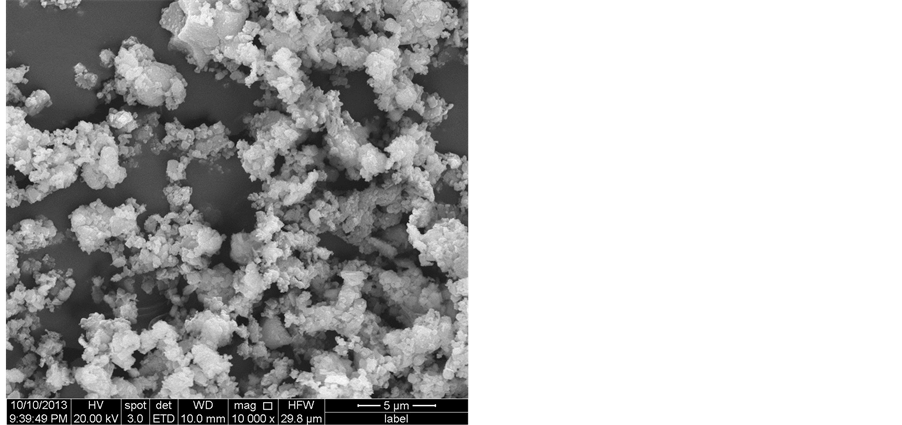 (a)
(a)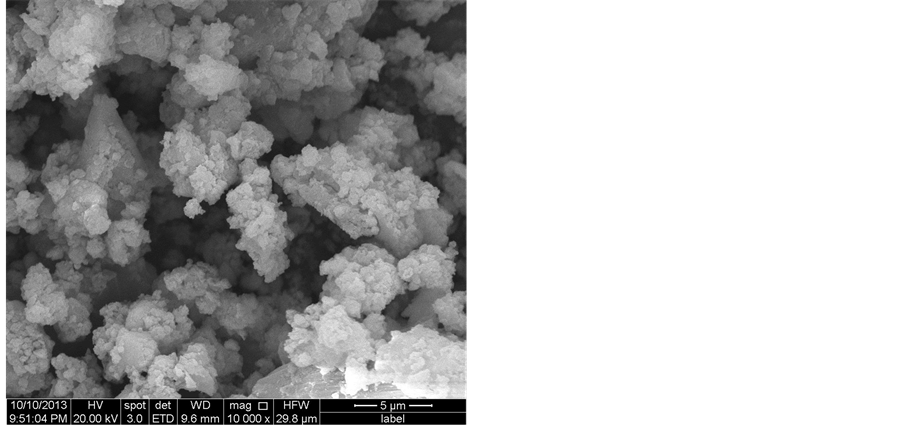 (b)
(b)
Figure 1. SEM images of RM (a) and RAM (b).
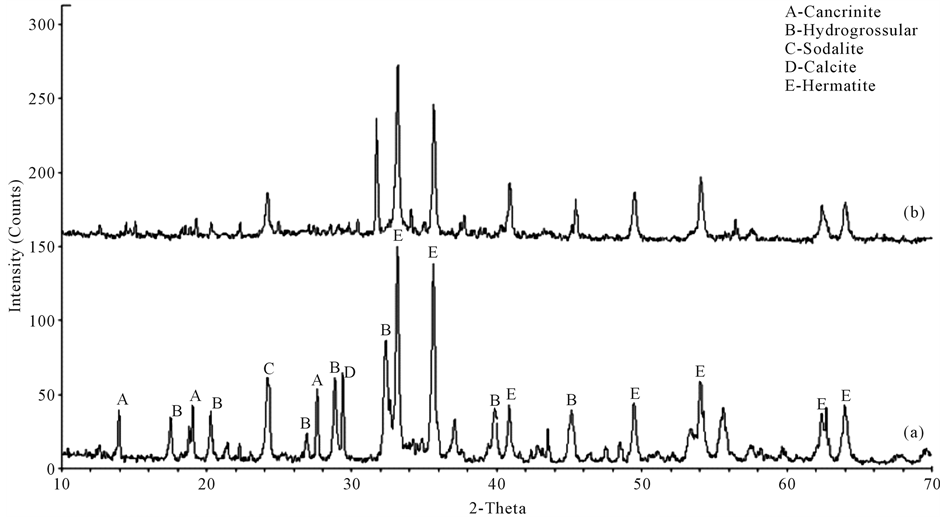
Figure 2. X-ray diffraction of RM (a) and ARM (b).

Table 1. The chemical composition of RM after modification (%).

Table 2. The adsorption hexavalent on different activated red mud.
humid environment, hydroxylated surfaces of these oxides developed charge on the surface. When the red mud was added into a solution, there exists such surface hydrolysis reactions depending on pH [24] -[26] :
 (3)
(3)
 (4)
(4)
At pH 2, the species of hexavalent chromium that predominates is , which can react to ARM as follows:
, which can react to ARM as follows:
 (5)
(5)
 (6)
(6)
On the other hand the adsorption of hexavalent chromium on the ARM is 94.26% at pH 2. Because, at lower pH, the solution pH values below the pHpzc of the adsorber, the surface of adsorber particles is positively charged. The ARM surface is positively charged, it can absorb  ion.
ion.
This implied that the adsorption processes of hexavalent chromium were neither purely physical nor chemical processes, but a combination of the two processes. The possible adsorptions between the ARM and hexavalent chromium are electrostatic attraction and ligand exchange [27] [28] . The results are very similar to those reported by Erdem in his study of hexavalent chromium remove by using heat-activated bauxite [29] .
3.3. Adsorption of Hexavalent Chromium on ARM
3.3.1. Effect of Adsorbent Dosage
Adsorbent dosage is an important parameter because it determines the capacity of an adsorbent for a given initial concentration of the adsorbate. The effect of adsorbent has been studied on hexavalent chromium removal and the results have been illustrated in Figure 3(a). In general, the increase in adsorbent dosage increased the percent removal of adsorbate. As the adsorbent dosage was increased from 0.1 to 0.5 g, the hexavalent chromium adsorption efficiency increased from 6.69% to18.35% for RM. Because number of active sites increases with respect to increase of adsorbent dosage. However, the hexavalent chromium adsorption efficiency was decreased when the adsorbent dosage was more than 0.5 g. The adsorbent dosage increase can lead to the pH of the test solution being increased, and high pH is not conducive for hexavalent chromium adsorption. Under the same conditions, the hexavalent chromium maximum adsorption efficiency of ARM reached 92.21%. This was because acid treatment RM can increase specific surface area and porosity. Taking into account the above results, the dosage of hexavalent chromium adsorption was set as 0.5 g in the following experiments.
3.3.2. Effect of Contact Time
The important findings were represented in Figure 3(b) which revealed that, hexavalent chromium adsorption efficiency increases with increasing contact time until the state of equilibrium is reached. It was clear that the removal of hexavalent chromium can be derived into two stages: the first stage showed high adsorption efficiency is very high, followed by a second stage with much lower adsorption efficiency. At a contact time of 120 min, 92.34% greater maximum sorption occurred. Thus, a period of 120 minis is adequate for adsorption of hexavalent chromium onto ARM.
3.3.3. Effect of pH
The solution pH is another important parameter and it has a strong effect on the adsorption of hexavalent chromium on the surface of the ARM. Hexavalent chromium can be represented in various forms such as H2CrO4,  ,
,  and
and  depending on the pH. H2CrO4 predominates at pH less than about 1.0. While in the pH range of 1 - 6 different forms of chromium ions such as
depending on the pH. H2CrO4 predominates at pH less than about 1.0. While in the pH range of 1 - 6 different forms of chromium ions such as  and
and  coexist, being
coexist, being  predominant. As the pH increases, this form shifts to
predominant. As the pH increases, this form shifts to  and
and . At pH greater than 7.5,
. At pH greater than 7.5,  is the only hexavalent chromium species in aqueous phase [30] . The existing balances among different ionic species of hexavalent chromium are given as follows:
is the only hexavalent chromium species in aqueous phase [30] . The existing balances among different ionic species of hexavalent chromium are given as follows:
 (7)
(7)
 (8)
(8)
 (9)
(9)
The solution pH relative to the point of zero charge (pHpzc) for the ARM also needs to be considered. At pH values below the pHpzc of the adsorber, the surface of adsorber particles is positively charged and as the pH rises above the pHpzc, anion adsorption decreases. The pHpzc for activated red mud has been reported as about 8.5 in Ref. [31] . The maximum adsorption efficiency of hexavalent chromium was obtained at pH 2 while the adsorption decreased when the pH increased as can be observed in Figure 3(c). The decrease of adsorption efficiency in the alkaline pH range (pH > 8.5) may be due to the competition of the OH− with the hexavalent chromium for surface sites on ARM or electrostatic repulsion of hexavalent chromium ion to the negatively charged surface. A similar type of behavior was also reported for the adsorption of hexavalent chromium on bauxite tailing [32] and montmorillonite [33] .
3.3.4. Effect of Reaction Temperature and Thermodynamic Parameters
Temperature dependence of the adsorption process is associated with several thermodynamic parameters. It was observed in Figure 3(d) that the hexavalent chromium adsorption efficiency decreases with increasing temperature and maximum adsorption of hexavalent chromium was obtained the temperature of the solution at 30˚C.
In order to study the feasibility of the adsorption process, the change in free energy (∆G), enthalpy (∆H) and entropy (∆S) of adsorption were calculated by using the following equations [34] :
 (10)
(10)
 (11)
(11)
 (12)
(12)
where Qe and Ce represent the concentration (mg∙L−1) of hexavalent chromiumon adsorbent and in solution, KD is the distribution coefficient, R is the universal gas constant (8.314 J∙mol−1∙K−1) and T is the absolute temperature (K). Thermodynamic parameters, ∆H and ∆S were calculated from the slope and intercept of the plot of
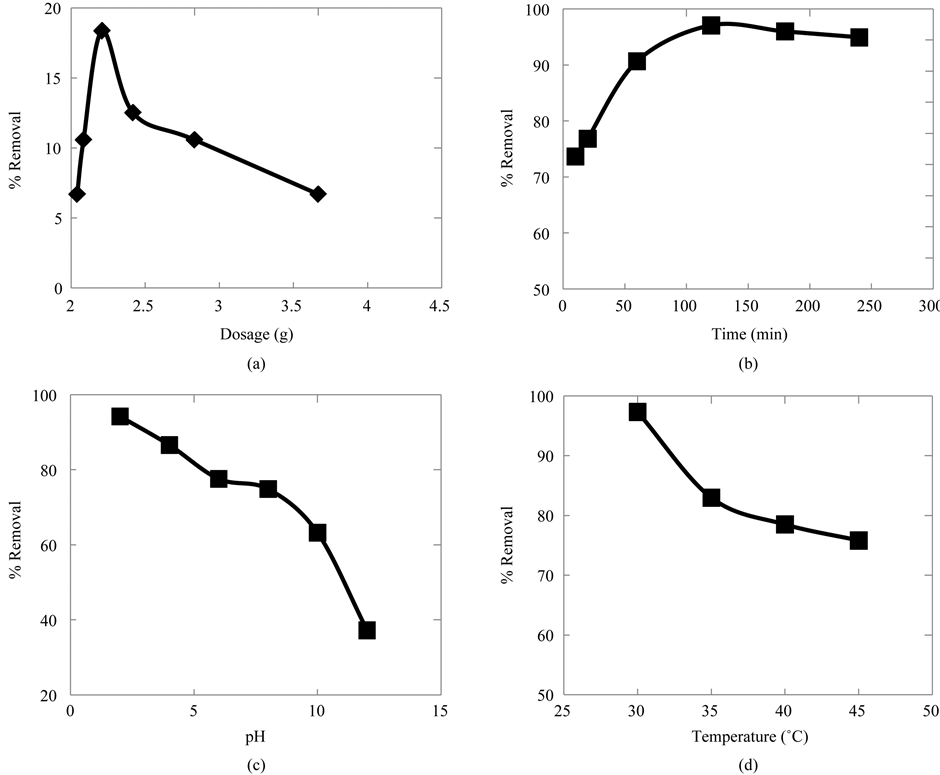
Figure 3. Effect of adsorbent dosage (a), contact time (b), pH (c) and the reaction temperature (d) on hexavalent chromium adsorption percentage.
lnKd against 1/T. Values of ∆H, ∆G and ∆S are represented in Table 3. The positive values of ∆G indicate that the sorption of hexavalent chromium onto ARM was not spontaneous processes. Enthalpy change of absolute value of chemical adsorption is greater than 20 kJ∙mol−1 [35] . The enthalpy change ∆H had a value of 123.31 kJ∙mol−1 for the adsorption of hexavalent chromium, and it suggests that hexavalent chromium adsorbs onto ARM in the form of chemical adsorption. The negative ∆S values signify there is a decrease in therandomnessat the solid-solution interface of hexavalent chromium onto ARM.
3.4. Adsorption Isotherms
Langmuir and Freundlich isotherm equations are used to establish the relationship between the amount of hexavalent chromium adsorbed by ARM and their equilibrium concentration in aqueous solutions. These isotherms are as follows:
1) Langmuir isotherm
 (13)
(13)
where KL is the Langmuir adsorption constant (L∙mg−1) and Qmax is the monolayer adsorption capacity of the adsorbent (mg∙g−1). Langmuir adsorption isotherm equation assumes that adsorption occurs at specific homogeneous sites within the adsorbent.
2) Freundlich isotherm
 (14)
(14)
where KF (L∙mg−1) and n are Freundlich constants related to adsorption capacity and adsorption intensity, respectively. Freundlich adsorption isotherm equation assumes a heterogeneous adsorption surface with sites that have different energies of adsorption and are not equally available.
It can be seen from Table 4 and Figure 4 that the Langmuir isotherm equation better fitted than the Freundlich isotherm equation by comparing the results of correlation coefficient values. This was due to homogenous distribution of active sites on the ARM surface, since the Langmuir isotherm equation assumes that the surface is homogeneous. The monolayer adsorption capacity of ARM was found as 0.03 mg∙g−1. In order to calculate the adsorption efficiency of the adsorption process and to know whether the process is favorable or unfavorable for

Table 3. Thermodynamics parameters of hexavalent chromium adsorption onto ARM.
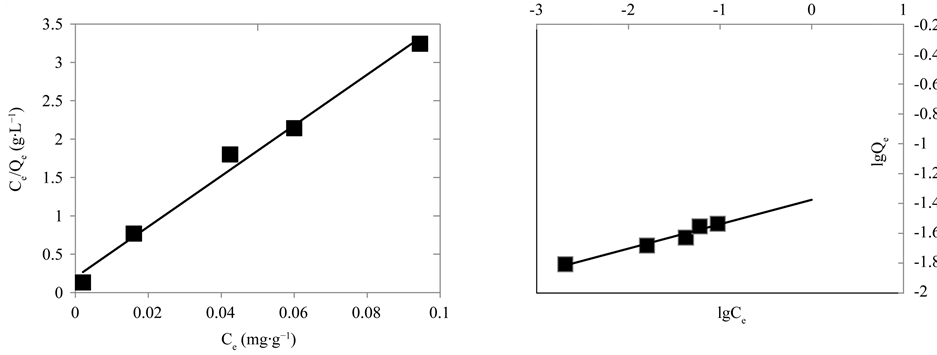 (a) (b)
(a) (b)
Figure 4. Langmuir (a) and Freundlich (b) plots for the adsorption of hexavalent chromium onto ARM.

Table 4. Langmuir and Freundlich constants and correlation coefficient of the adsorption of hexavalent chromium onto ARM.
the Langmuir type adsorption, the dimensionless equilibrium parameter (RL) was calculated using the Langmuir adsorption constant obtained from the Langmuir isotherm as follows:
 (15)
(15)
where C0 is the initial hexavalent chromium concentration (mg∙L−1). As the RL values lie between 0 and 1, the adsorption process is favorable [36] . The calculated RL values found in this study are between 0.07 and 0.0245 for 0.08 - 0.24 mg∙L−1 concentration of hexavalent chromium adsorption onto ARM, representing favorable adsorption process.
3.5. Research Prospects
Due to limitations in experimental conditions, there is a lot of research to be done. This study selects the static adsorption experiment to explore the performance of the adsorbent. But in actual situation, wastewater is usually continuous flow. So the performance of the adsorbent could be differences in practical engineering application. Adsorbent regeneration performance determines the practical application value of adsorbent. Research on adsorbent regeneration performance evaluation has not been carried out, in the subsequent experiments, regeneration and reuse of adsorbents will be the focus of research.
4. Conclusions
The present work shows that thermally activated acid neutralized red mud can be used as adsorbent for the removal of hexavalent chromium from aqueous solutions successfully. SEM image indicated clearly the structural transformation of the RM after modified. The XRD and XRF studies revealed that RM contains significantly more metal ions than ARM. All the characteristics analysis indicated the successful modification of RM. The ARM has shown good adsorptivity for hexavalent chromium. For the solution of 0.08 mg∙L−1, the maximum adsorption yield is found as 97.31% when 0.5 g sorbent was added in solution at pH 2 and temperature: 30˚C. The adsorption efficiency decreased with an increase in temperature indicated that the adsorption process was exothermic. The experimental data fitted well with Langmuir isotherm equation, as the homogenous adsorption occurred. Adsorption of hexavalent chromium on ARM is a result of the electrostatic attraction and ligand exchange.
Additionally, the red mud is discarded as waste in bauxite processing industry, its utilization as adsorbent for removal of hexavalent chromium is expected to be economical. The results of this study indicated that ARM has the potential to be used as an alternative adsorbent material for the removal of hexavalent chromium from water.
NOTES
*Corresponding authors.